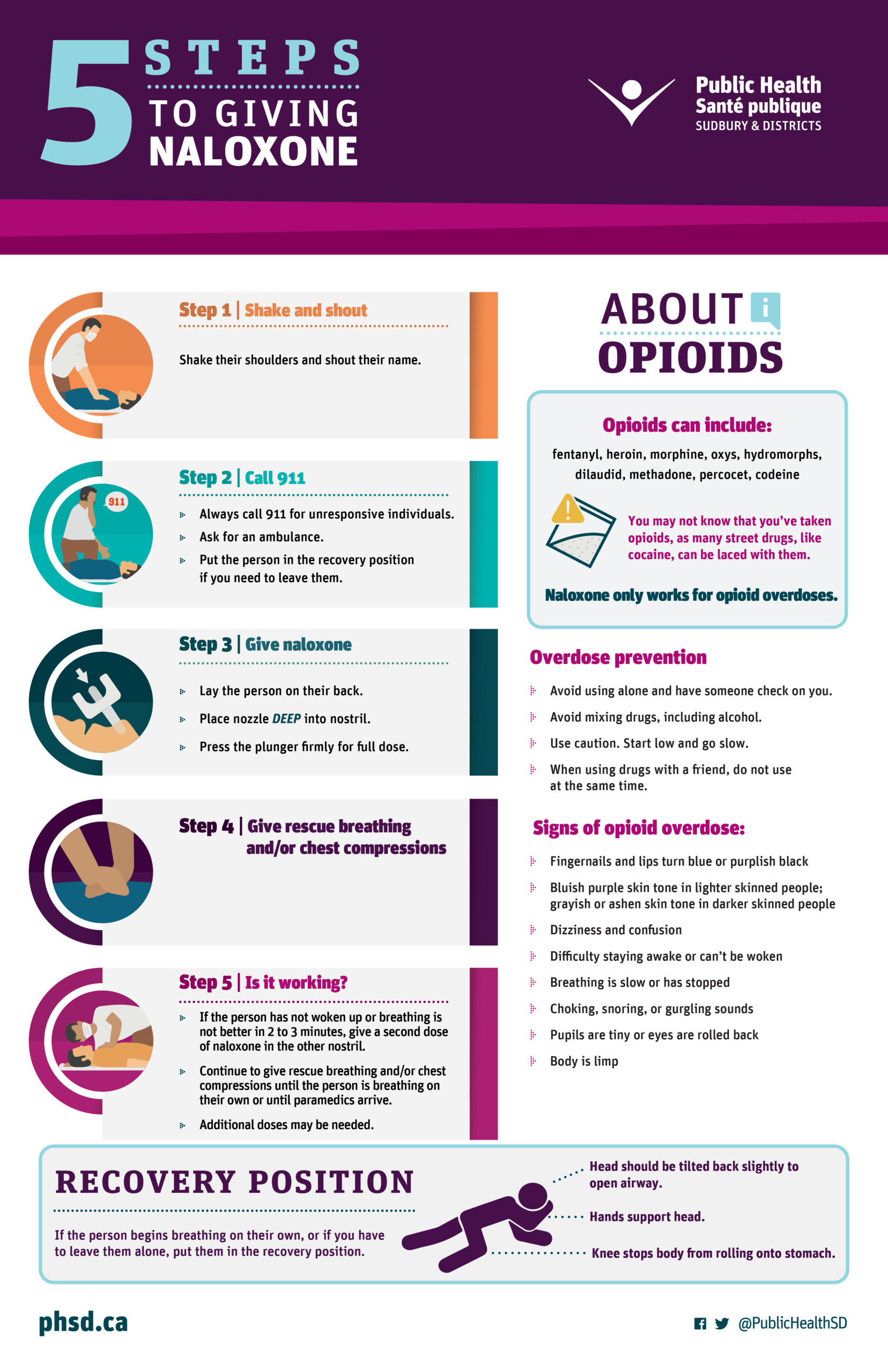Naloxone
Naloxone (also known as Narcan®) can temporarily reverse the effects of an opioid poisoning that may cause a person to stop breathing. If you witness an opioid poisoning, call 911 and stay with the person until emergency services arrive. By carrying naloxone, you may have the opportunity to save a life.
Where to get naloxone?
For a free naloxone kit, visit one of Public Health Sudbury & Districts locations, Réseau Access Network, or ask your local hospital or pharmacy. You can also visit www.ontario.ca/page/get-naloxone-kits-free.
Learn how to administer naloxone (Vimeo).
Opioid poisoning symptoms
- fingernails and lips turn blue or purplish black
- skin turns bluish purple, grayish, or ashen, depending on skin tone
- dizziness and confusion
- the person can’t be woken up
- choking, gurgling, or snoring sounds
- slow, weak, or no breathing
- drowsiness or difficulty staying awake
How to respond to an opioid poisoning
- GIVE NALOXONE. This will help reverse an opioid poisoning and will do no harm if the poisoning is not due to opioids. This may improve breathing, but the person may not regain consciousness due to sedation. Additional doses may be needed.
5 steps to giving naloxone
Step 1 | Shake and shout
Shake their shoulders and shout their name.
Step 2 | Call 911
- Always call 911 for unresponsive individuals.
- Ask for an ambulance.
- Put the person in the recovery position if you need to leave them.
Step 3 | Give naloxone
- Lay the person on their back.
- Place nozzle DEEP into nostril.
- Press the plunger firmly for full dose.
Step 4 | Give rescue breathing and/or chest compressions
Step 5 | Is it working?
- If the person has not woken up or breathing is not better in 2 to 3 minutes, give a second dose of naloxone in the other nostril.
- Continue to give rescue breathing and/or chest compressions until the person is breathing on their own or until paramedics arrive.
- Additional doses may be needed.
Recovery position
If the person begins breathing on their own, or if you have to leave them alone, put them in the recovery position.
- Head should be tilted back slightly to open airway.
- Hands support head.
- Knee stops body from rolling onto stomach.
Good Samaritan Drug Overdose Act
The Good Samaritan Drug Overdose Act provides some legal protection for individuals who seek emergency help during an opioid poisoning.
The Act is intended to reduce fear of police attending opioid poisoning events, encourage people to help save a life and applies to anyone seeking emergency support during an opioid poisoning, including the person experiencing an opioid poisoning. The Act protects the person who seeks help, regardless of whether they stay or leave the opioid poisoning scene before help arrives. In Ontario, the Act also provides some protection for anyone else who is at the scene when help arrives.
Naloxone kits for workplaces
- Distribution of naloxone to workplaces is the responsibility of the Ministry of Labour, Immigration, Training and Skills Development.
- Find out if your business is required to have a naloxone kit at the workplace.
- Further questions about the Naloxone Workplace Program can be directed to PreventionFeedback@ontario.ca.
Information for health care providers and those working in harm reduction
The Ontario Naloxone Program, a program of the Ontario Ministry of Health and Ministry of Long-Term Care, has designated eligible community organizations to increase the distribution of naloxone to those most at risk of opioid poisoning.
Eligible organizations (as defined by the Ministry of Health) include
- community health centres (including Aboriginal health access centres)
- AIDS service organizations
- outreach organizations
- shelters
- withdrawal management programs
- police and fire services
- hospitals with an emergency department
- urgent care centres
- St. John Ambulance
- emergency medical services
- community paramedicine
- general hospital distribution
If you have any questions, or are an organization interested in participating in the Ontario Naloxone Program, please contact the Mental Health and Substance Use team or email naloxone@phsd.ca.
Related Pages
- Public Health Sudbury & Districts – Opioid Surveillance (phsd.ca)
- Community programs, supports & services
- The Point
Additional Resources
- EENet | carrynaloxONe: Training Materials (camh.ca)
- Harm Reduction Fundamentals: A toolkit for service providers (catie.ca)
- Ontario Harm Reduction Network (ohrn.org)Overcoming Stigma Through Language: A Primer (ccsa.ca)
- Indigenizing Harm Reduction(nativeyouthsexualhealth.com)
Helpful Links
- National Overdose Response Service (nors.ca)
- CCENDU Alerts and Bulletins | Canadian Centre on Substance Use and Addiction (ccsa.ca)
- Opioid Interactive Tool (publichealthontario.ca)
- Toronto’s drug checking service (drugchecking.community)
This item was last modified on October 15, 2024

